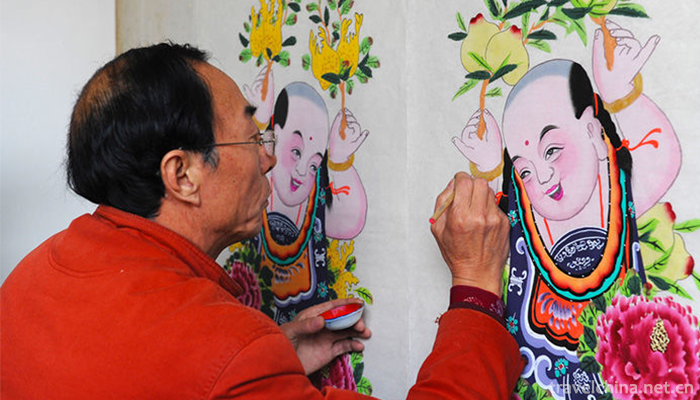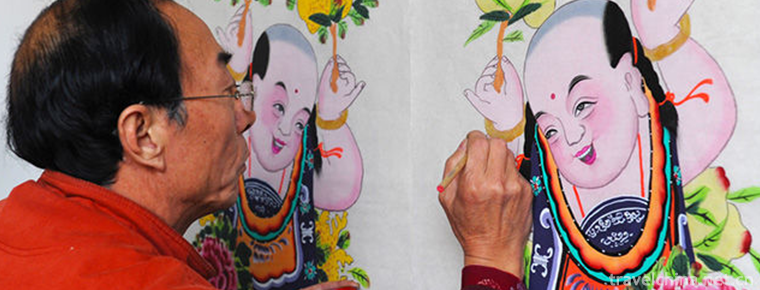High Density Gray Spring Festival Pictures
High Density Gray Spring Festival Pictures
Gaomi gray-flushing New Year painting, also known as "folk freehand painting", is one of the national intangible cultural heritage of Gaomi folk traditional art in Shandong Province.
Gaomi Spring Festival Painting originated in the early Ming Dynasty. Its originator was a Wang family in Gongpo Temple Village, Gaomi Beixiang. High-density gray New Year paintings mostly use full-open paper to draw, with great advantages. From the composition, they often adopt simple but not complicated methods. In addition to flower screen and figure paintings, they pay attention to highlighting the tall and plump image of the characters, they rarely use background or even omit background, so that the characters occupy the space of the picture, forming a two-dimensional perspective of the plane composition, which has a very striking effect.
On May 20, 2006, Gaomi Ash Pushing New Year Pictures were approved by the State Council to be included in the first batch of national intangible cultural heritage list.
historical origin
Gaomi Spring Festival Painting originated in the early Ming Dynasty. It is said that its founder was a Wang family in Gongpo Temple Village, Beixiang, Gaomi. The family migrated from other places, forced to make a living, copied some posters and temple murals stalls for sale, slowly mastered some skills, and constantly explored, burned the willow branches available everywhere into charcoal sticks as brushes, and carved pickles into seals and printing moulds. Since then, the Gaomi new year painting with folk style of art has been brought into the countryside with the local flavor of the countryside and the traditional customs of the peasants.
During the reign of Qianlong in the Qing Dynasty, the Wang family of Gongpo Temple Village began to accept apprenticeship, first taking four sons of Zhang family of Gongpo Temple Village as apprentices. After the completion of their studies, the Zhang brothers began to sell their paintings in workshops with innovative themes, which expanded the influence of the new year's gray-flushing paintings.
At the end of Qianlong Dynasty, some people from Gaomi Lijiazhuang, Zhaojiahuan and Dujiaguanzhuang visited their parents-in-law's temple to pay tribute to Zhang's brothers. They returned home with their art and started workshops and apprenticeships.
During the Jiaqing year, the new technology of combination of painting and printing began to be used in high-density gray-flushing New Year pictures. At that time, Hu San, who had been stereotyped in Yangliuqing Painting Store in Tianjin, came to Gaomi Lijiazhuang and put himself under Hu Yuxian's door. He blended the techniques of Yangliuqing woodcut New Year pictures into the production of gray-flushing New Year pictures. First, he engraved the prints, then finished the pictures by hand-painting, so that each picture can be produced in batches in a short time, and the efficiency is improved. Because of the double growth of economic benefits, many painters have redrawn this kind of New Year's painting, which is called semi-printing and semi-painting.
Cultural characteristics
Artistic characteristics
Looking at the artistic style of high-density gray-flushing New Year paintings in different periods of development, the early gray-flushing New Year paintings were deeply influenced by Temple murals, generally more work and less intentions, rough style. Except for the hand and eyebrows of the characters, other parts were quickly smeared, mainly ink and wash, which appeared simple and elegant, and were called "old painters". Since the Qianlong period of the Qing Dynasty, the gray-flushing New Year paintings have changed the black intuition of the "old paintings" and formed a new style.
Composition characteristics
High-density gray New Year paintings are mostly full-open paper paintings, with the advantages of big, common are "big coat", "big horizontal cloak", "four screens", "eight screens" and so on. From the composition point of view, we often adopt simple but not complicated methods. In addition to flower screen and figure painting, we should pay attention to highlighting the tall and plump image of the characters. We should use less background or even omit background to make the characters occupy the space of the picture and form a two-dimensional perspective of the plane composition, which has a certain striking effect.
Expression techniques
Even if it is a huge scene of the story, Gaomi New Year's Gray-Pushing Picture only chooses a key scene and draws the finishing touches, only draws a part of the key points. As for the charm of "related events" or "thousands of horses", it leaves the audience to associate and appreciate. Like Changbanpo, the author only draws the image of Zhao Yun waving a sword, leaving out all the other characters. In fact, this method of expression coincides with the simplicity of Beijing Opera performing art and the unexpected method of Chinese painting art.
Production process
The production of the new year's ash painting is based on the subject matter conceived by the author. After the abdominal draft is made, the outline is drawn with the charcoal bars fired by willow branches, that is, the powder draft, and then it is put on the other white paper, which is called "flushing and smearing". This is the first process of putting out gray New Year's pictures, so that several sketches can be wiped out. If you increase the quantity, you can use the willow charcoal stick to draw again on a good drawing and repeat it.
The second procedure for making gray New Year's paintings is "hand-painted". "Push and erase" is the foundation, and "hand-drawn" is the key. "Hand-painted" is much more complicated, mainly including "brushing wildly", "meticulous and delicate drawing", "sketching drawing", "pink face", "washing hands", "coloring", "opening eyebrows", "sketching lines", "shampooing flowers", "salted cauliflower", "golden description", "painting oil" and other steps.
Theme works
The themes of the new year's paintings include mountains and rivers, fish, birds and flowers, myths, opera characters, emperors and generals, gifted scholars and beautiful women, etc. According to incomplete statistics in 2009, there are more than 150 kinds of gray-flushing New Year pictures, such as "Yeming Recruitment", "Yellow Crane Tower", "King Li Jing" and "Sanniang Godfather" in the Qing Dynasty.
Inheritance and protection
Inheritance value
Gaomi Spring Festival Painting embodies the connotation of Gaomi secular culture. The sacrificial paintings of Gaomi Family Hall almost contain all the cultural connotations of Chinese folk New Year Painting, which is one of the core functions of family hall's secular filial piety culture.
Inheritance status
The production characteristics of high-density gray-flushing New Year pictures make it impossible to break away from the traditional hand-flushing and drawing skills, which results in long production cycle, exquisite technology and limited production. Thus, gray-flushing New Year pictures can not compete with plate-making and printing technology in the market, and the whole industry began to decline during the Guangxu period. Grey Spring Festival painting skills in high-density areas have been inherited by no one. As a unique variety of New Year's paintings, it reflects the social culture, customs and customs, and preserves the traditional skills of Chinese folk painting. It is necessary to rescue and excavate it.
Inheriting characters
Lu Junli, male, Han nationality, born in 1953 in Gaomi, Shandong Province. The first batch of national intangible cultural heritage projects are representative inheritors of high-density gray-flushing New Year pictures. His representative works include: Birthday Pictures, Boguping, Samsung Pictures and so on.
protective measures
In 2009, Gaomi City was named "Town of Chinese Gray Pulling New Year Pictures" by the Chinese Folk Literature and Art Association, and established a protection base for gray Pulling New Year Pictures, which played a certain role in training inherited talents.
social influence
Important exhibitions
On March 20, 2015, under the guidance of the Non-Heritage Department of the Ministry of Culture of the People's Republic of China, the Gongwang Mansion Management Center of the Ministry of Culture and the Organizing Committee of the Productive Protection Series of China's Non-material Cultural Heritage, and the National Non-material Cultural Heritage-Traditional New Year Paintings Exhibition sponsored by the Research and Protection Center of Chinese Traditional Arts of the Gongwang Mansion of the Ministry of Culture, opened at the Gongwang Mansion Chinese Traditional Arts Exhibition Gaomi's New Year's Gray-Pushing Paintings are displayed in it.


-
1.White cut chicken
White cut chicken, also known as white cut chicken, is the most common dish in Guangdong cuisine. It is a kind of chicken dipping. Its characteristics are simple and easy to prepare, without batching
Time 2018-11-02 -
2.The Qiaos Famaily Compound
The Qiao's Famaily Compound: National AAAAA-level tourist attractions, national key cultural relics protection units, national second-level museums
Time 2018-11-24 -
3.MountHuaguoshan
Mount Huaguoshan (Lianyungang Huaguoshan Scenic Area) is located at the middle foot of Nanyuntai Mountain in Lianyungang City.
Time 2018-12-06 -
4.Fairy Lake Xianhu Botanical Garden
Xianhu Botanical Garden is located in Liantang Xianhu Road, east suburb of Luohu District, Shenzhen. It relies on Wutong Mountain in the East and Shenzhen Reservoir in the west.
Time 2018-12-22 -
5.Tone tune
Colour tune, commonly known as tune, colour tune, colour lantern, Na Hao Hey and so on, is one of the local operas in Guangxi. It belongs to the system of Lantern opera
Time 2019-04-04 -
6.Material liao qi
Material wares are traditional handicraft products in Beijing. It is a traditional handicraft made of glass strips. There was no direct glass-making industry in Beijing. The materials used were collec
Time 2019-05-13 -
7.Running curtain
Running curtain originated in the Spring and Autumn Period and Warring States Period, formed in the Qin and Han Dynasties, flourished in the Song, Yuan, Ming, Qing Dynasty and the early Republic of Ch
Time 2019-06-09 -
8.Qijia Yanxi
"Qijia Yanxi" is a long narrative poem in Tu folk literature. It records the eleventh generation of Qi Tusi Chief Qi Yanxi in the history of Tu people, despite his old age and physical decli
Time 2019-06-10 -
9.Bai Juyi
Bai Juyi (772 - to - 6), Le Tian, the number of Xiangshan residence, and Mr. drunken Yin, whose ancestral home is Taiyuan, Shanxi. And moved to his great grandfather. Lower jaw Born in Henan Xinzheng
Time 2019-09-06 -
10.Gong Shuban Lu Ban
Luban (507 BC - 444 BC), Lu people in the spring and Autumn period. Ji surname , a two-character surname Name, class, person. Public transport plate , Public like , Class lose It is also known as &quo
Time 2019-09-07 -
11.Cao Tiancheng
Cao Tian Cheng, Sui Dynasty people. According to the history of Sui Dynasty in the twenty four histories, Cao Tian is also known as "Tiancheng". Ask for advice Bo Yang, Jiangxi. At the end o
Time 2019-09-14 -
12.Dazhou highway
Dazhou is one of 179 main hubs of highway transportation in China and one of 12 regional secondary hub cities in Sichuan Province. It is a secondary logistics center city in national layout planning and an important logistics hub city in Western Chin
Time 2020-12-20